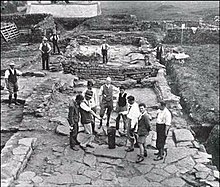Born: 12 January 1906 Eccles, Lancashire, England
Died: 20 October 1995 Carvoran House, Greenhead, Northumberland, England
Known for: Excavations of Hadrian's Wall at Vindolanda
Studies into the organisation and methods of the Roman Army
Studies into the organisation and methods of the Roman Army
Eric Birley was a English historian and archaeologist, particularly associated with the excavation of the forts of Hadrian's Wall, notably at Vindolanda.
Education and career
Birley was educated at Clifton College. He then studided classics at Brasenose College, Oxford, where he obtained a double first in Mods and Greats. He was influenced in the study of history and archaeology by Michael Holroyd, his Brasenose tutor; R. G. Collingwood, the renowned authority on Roman Britain; and F.G. Simpson, Director of Field Studies at Durham, and a great influence on Birley vis-à-vis the art and science of excavation.
Under the direction of F.G. Simpson, Birley began excavating at Hadrian's Wall in 1927 while an undergraduate. Birley's first archaeological dig occurred at Birdoswald. After graduating from Oxford, Birley worked for a short time for the Society of Antiquaries of London acting as a construction site observer for the Society. It was during this period in London that Birley befriended Mortimer Wheeler of the London Museum engendering in Birley a lifelong interest in "imported Roman 'samian' pottery with moulded decoration." A chance discovery in 1929 of two inscription stones in the praetentura at Birdoswald led Birley to suggest redating the Wall periods. This discovery, and Birley's redating, impacted the study of Roman Britain tremendously inasmuch as it "has formed the basis of all subsequent work on the chronology of Hadrian's Wall."
In 1929, having developed a keen interest in the Wall through his excavations, Birley succeeded in buying the Clayton Estate at Chesterholm that had belonged to Anthony Hedley, the 19th century antiquary. Nearby Houselands would also come up for sale; however, Birley could
not afford the purchase of both properties, although he would eventually
excavate them both. Chesterholm-Vindolanda would eventually be converted into a museum and research centre, in which the spectacular finds from Vindolanda would be displayed and interpreted.
In 1931, at the age of 24, he became a lecturer at the University of Durham, "already with an impressive record of excavation on Hadrian's Wall, partly under the guidance of F.G. Simpson," whom he would replace upon the latter's stepping down as Director of Field Studies. Through trips to Germany and Switzerland, he began to expand his expertise in samian pottery, epigraphy, and his primary field of interest, the Roman army. As a consequence of these trips abroad, his continental reputation grew.
In 1943, he was promoted to Reader. In 1947, he became Vice Master of Hatfield College. In 1949, he was promoted to Master of Hatfield. He would finish his academic career having been Master of Hatfield College (1949–1956); Professor of Romano-British History and Archaeology (1956–1971); Head of the Department of Archaeology (1956–1971); and Dean of the Faculty of Social Sciences (1968–1971).
In 1949, Birley established the first International Congress of Roman Frontier Studies. During his tenure, he was president of all three of the local archaeological societies.
Also, during his years at Durham, he would influence such notable
students as George Jobey and John Gillam, each of whom would go on to
hold prestigious university teaching positions. One student recalls that Birley was "incredibly generous and trusting in … [his] … support to students."
Birley would become known as an expert on the Roman army. For his
"practical experience of the ways in which modern armies work," he was
inspired in asking questions about organisation and methods of the Roman
army. His expertise and work in this field served to make Birley the founder of the "Durham School" of archaeology having attracted several highly-talented and influential postgraduate students to the
Department, whose research has … "epitomised, and to a large degree set
the agenda for, British work on the Roman military for much of the
twentieth century." Often known collectively as the "Durham School," they include David Breeze (Chief Inspector of Ancient Monuments for Historic Scotland and Visiting Professor at Durham University since 1994), Brian Dobson (Emeritus Reader at Durham University), the late Mike Jarrett (former Professor at Cardiff University), Valerie Maxfield (Professor at Exeter University) and John Wilkes (Emeritus Professor at the London Institute of Archaeology).
Birley's influence is still very much alive in the Archaeology
Department at Durham University: "Durham Archaeology is still founded on
the vision and determination of its early pioneers, notably Eric Birley
and … [his] … influence lives on in successive generations of staff and
students."
In Birley's obituary, former Durham PhD student and Emeritus Yates Professor of Greek and Roman Archaeology at the Institute of Archaeology, John Wilkes wrote in The Independent
that "Eric Birley dominated the study of the Roman army, of Hadrian's
Wall and Roman frontiers in general for much of his 40 years as a
teacher at Durham University, interrupted only by six years of war
service, when he was engaged in the study of the German army for
Military Intelligence."
_002.jpg)

No hay comentarios:
Publicar un comentario